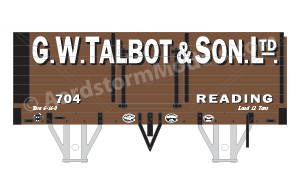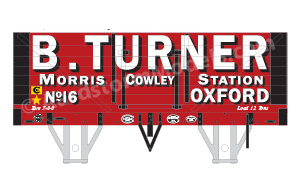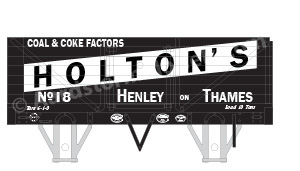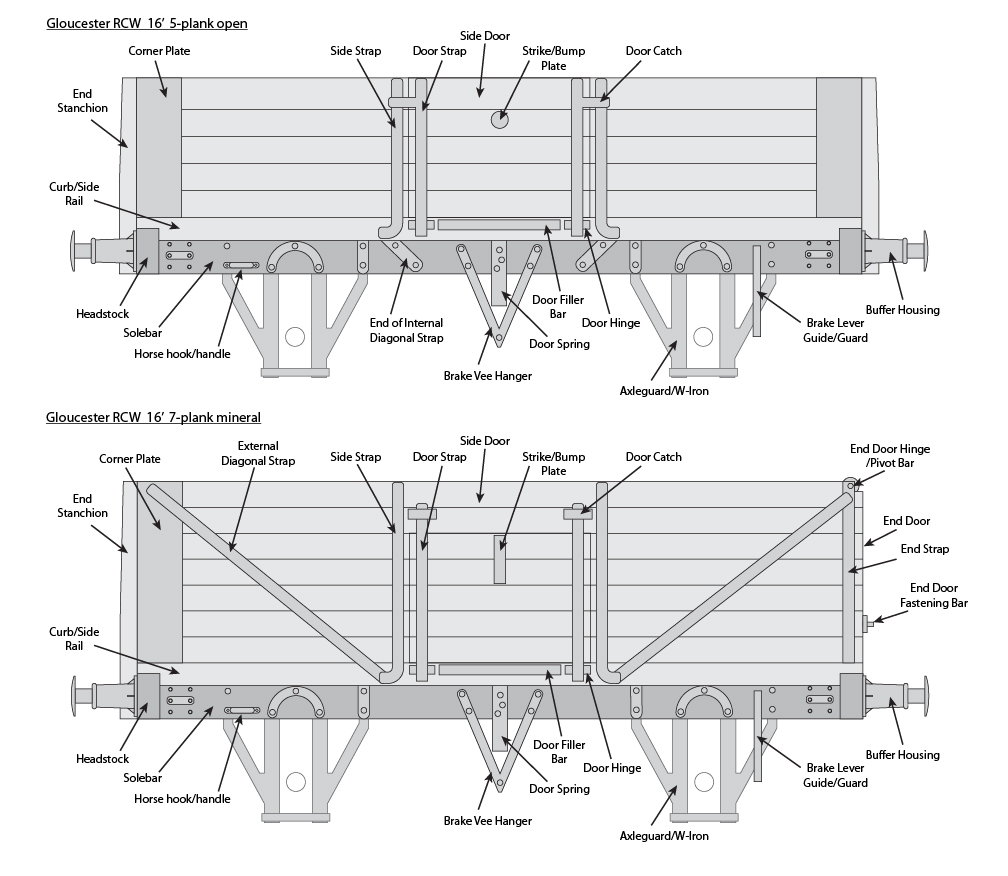Private Owner Wagon Decals
Mineral Wagons
This page describes my current range of decals for private owner liveries for model railway mineral wagons. A wide variety of different liveries are available in a variety of scales. They are all derived from real railway wagons, and are intended to reproduce the original livery as faithfully as possible. Many of the liveries date from the first couple of decades of the twentieth century, so configuration options are provied to allow a livery to be modernised in various ways, to cover the period up to the British Railways steam era, when such wagons were taken into BR ownership and eventually disappeared.
Originally, such wagons were used for journeys dictated by their owners, carrying coal or other minerals. Wagons operated by the collieries or other producers carried their products to their customers, and could range quite widely over the network. Wagons operated by merchants and other end-users were restricted to journeys between the user's home location and their chosen collieries or producers.
During World War 2, private owner wagons were pooled and became "common user", that is, they could be used for any journey, not just those required by their owners. Thus any wagon could potentially be seen anywhere on the railway network.
After the war it was intended that the wagons would be returned to their original owners, but nationalisation meant that they came under British Railways ownership instead, and therefore still ranged widely over the network
Prior to the war such wagons were probably reasonably well maintained, and repainted periodically or after major repair. Wartime restrictions and shortages meant that maintainance fell to an absolute minimum, and repairs to the woodwork generally went unpainted. The situation continued after nationalisation, with wagons gradually decaying until no longer usable and were scrapped.
To help model wagons in the WW 2 and post-nationalisation periods, I offer configuration options for weathering and dilapidation. see below for full details.
The original wagon liveries were designed to fit a particular type and size of wagon. It is quite possible that a suitable kit or model for the original wagon type is not available in the scale you are working in. I therefore offer configuration options for substituting a different wagon type for which a suitable kit or model may be more readily available. I will then adjust the original livery elements to fit the new wagon type.
The range of configuration options available is quite extensive, so once I have generated the artwork for your chosen wagon in response to your order, I will send you an illustration by e-mail, for you to check and if necessary make changes before I finally print your decals and send them to you.
A small selection of the available wagon liveries is illustrated below, to whet your appetite. The full range is illustrated on a separate pattern selection page, available here. The range of substitute wagon types is also illustrated on a separate selection page, available here.
My initial range of liveries concentrates on merchant's wagons for the eastern core of the GWR territory, i.e. Berkshire, Oxfordshire and Gloucestershire, plus a few extras, as the books I started with to find livery information were for lines in this area. I also have a lot of books covering other areas and colliery wagons. The first batch of liveries for South Wales collieries have now been added, with more to come. Other colliery and merchants' areas will then follow. The range of corresponding wagon types has also been expanded.
If you want a specific livery that is not currently part of my standard collection, I may well already have the necessary information to produce suitable decals. Please contact me with details (preferably identifying a source book containing the information) and I'll see what I can do to add the decals to my range. If I don't already have the necessary information, are you able to supply it (at least a clear photo)? I will also gladly prepare custom decals for a fictional wagon livery, such as for the coal merchant of your fictional model railway station.
Terminology
To help wih the terms used in the descriptions below, the following diagram identifies the major components of a typical open or mineral wagon, with wooden body and underframe.
I draw a distinction between open wagons and mineral wagons, although both types as private owner wagons were used to carry minerals such as coal and coke:
- An open wagon is one with drop-down side doors that extend the full height of the body sides, and does not have end or bottom doors. It is thus identical to the wagons used to carry general merchandise.
- A mineral wagon is one with side doors for which the drop-down part stops short of the top of the body sides. It may have additional door(s) above the drop-down part that could be hinged at the sides or open vertically. Otherwise the topmost planks continue uninterrupted across the door opening. Mineral wagons may also have a door at one end, opening the full width and height of the wagon body and hinged at the top, and/or doors in the floor of the wagon. Such wagons were generally only used for mineral traffic.
The Decals
A set of decals will consist of a number of individual decals, each type of which are illustrated in the following image:
- A decal for each side of the body of the wagon. Note that for a wagon with an end door, the sides are different, one having the door on the right (as shown), the other on the left. The other livery elements are adjusted accordingly.
- A plain decal for each end of the wagon.
- A decal for each solebar, excluding the headstocks.
- A decal for the face and ends of each headstock.
The decals will be printed onto decal paper with a white backing film, up to A5 in size for ease of posting. Decals for the largest scales may need more than one sheet, and/or the decals may need to be divided into sections to fit. Where space is available, a spare of each decal will be provided for you to experiment with, or in case of problems during application. Full instructions for applying my decals will be provided with your first order, or are available here.
It is up to you whether you apply the decals in one piece, as designed, or cut them into smaller sections. One piece applicatiopn is probably practical in the smaller scales, where raised surface detail on your model is sufficiently shallow to not cause problems with the sit or distortion of the decals. In the larger scales such detail is likely to be high/thick enough to significanly "shorten" a one piece decal because of the extra length needed to wrap it around the projections. It is therefore likely to be better to cut the decals into sections along the edges of such details. Where lettering or other livery elements crosses a projection, you will need to fill the resulting gap between decal sections with appropriate paint to link the livery elements on either side.
Small projections such as bolt heads can usually be allowed to pierce through the decal during application. Once the decal is in position, press down firmly on the projections using your finger or a soft pad (such as kitchen paper folded on itself several times). Be sure to apply only vertical pressure; sideways pressure will cause the decal to slide out of position. Piercing of the decal can be assisted, if necessary, by using the tip of a sharp knife : either a single small "prick", or a small cross. Larger, but still small, projections can likewise be accommodated by small cuts during application. Cuts of significant length are best achieved by rocking the blade of a small round knife along the cut, rather than dragging the point of a straight knife.
Please also note the following:
- The "© AardstormModels.com" watermark in the livery illustrations will not be present in the decals; it is there to discourage people downloading and printing my designs for themselves.
- The overall size of each decal is slightly enlarged, with cutting guides provided to mark the actual size. This reduces the risk of any slight misalignment of your cut resulting in the inclusion of white background.
- The body side decals are extended so that the corner plate(s) can wrap around the ends of the wagon, thus avoiding having edges of the decal at the corner. In the smaller scales it may be practical to apply the decals in this way. In the larger scales it is probably better to cut the corner plates from the rest of the side and apply them separately, if at all.
- Plank edge detail, as seen in the livery and wagon type illustrations, is not present in the decals, unless you select certain weathering options. This is in case the plank detail on your model doesn't exactly match that in the design. Cutting guides are provided instead, in case you wish to cut the decals into sections horizontally to aid application; it minimises the appearance of decal edges if they coincide with surface detail.
- Ironwork edge detail is similarly omitted, again unless you select certain weathering options. Ironwork is therefore normally only included if it is picked out in a different colour in the design. Ironwork on the solebar decals is omitted altogether, even if a different colour, in case the positions don't match your model. Such details also often have significant height from the solebar surface, sufficient to cause problems if the decal were appplied in one piece, even in the smaller scales.
- Cutting guides are again provided to mark the positions of the ironwork in case you wish to cut the decals into sections vertically; the appearance of the decal edges is minimised if they coincide with the physical surface detail. The guides for each ironwork strip are linked together to indicate the width of the strip. If you do cut the decals in this way, it is up to you whether you make your cuts along the centre of the strip, or along one or both side.
- The solebar decals for wooden underframed wagons are extended up to floor height. The curb rail usually significantly overlaps and is separated from the top of the solebar in such wagons. Additional cutting guides are provided at curb rail level, in case your model doesn't include this recess behind the curb rail.
- The end decals will need to be cut vertically into sections to fit between the end stanchions of the fixed end, or for the door end, vertically to fit between the vertical strapping and horizontally to fit around the end door fastening bar. An overall width of 8 ft is assumed; some wagons are narrower (7 ft 6 in. was common for earlier wagons). It is up to you to work out where such cuts need to be made, to match your wagon, but cutting guides are provided for the corner plates and typical stanchion positions, and at 6 inch intervals to help with the vertical cuts.
- The end headstock decals include the headstock ends; it is up to you whether you wrap the decals around the ends, or cut the ends off and apply them separately (if at all). If the ends of your headstocks are tapered, you will have to cut the ends off. You will also need to cut the headstock decals into sections to accommodate any end stanchions and the buffers and couplings; cutting guides are provided to mark these features (assuming 10 inch widths for the buffers and coupling mount).
Configure Your Decals
To order a set of decals for a private owner wagon you will need to configure its specification. This will consist of a number of steps, as described below.
To accommodate a wide range of scales, wagon dimensions are specified in scale feet and/or inches, rather than model mm. A calculator and look-up table to help convert scale inches into model dimensions (or vice versa) is available here (opens in new browser tab/window).
Note: If you want a set of decals for a wagon that is not covered by the standard options below, I will be happy to quote you for a customised set. Please contact me with full details.





